Ants in Tishomingo State Park, Tishomingo County, Mississippi [MS State Park Ants]
Joe A. MacGown, JoVonn G. Hill, Rebekah J. Jones, Stephanie Larrick, and Oliver Yung
Uploaded August 2006; updated 12 August 2024
Tishomingo State Park is located just past mile marker 304 on the Natchez Trace Parkway in Tishomingo County, Mississippi. This beautiful 1,530 acre park, named for a famous leader of the Chickasaw nation, Chief Tishomingo, has rich sloped forests with large boulders and rock formations. Bear Creek and other smaller creeks run through the park and there is a nice sized lake present as well. The park offers cabins, camping sites, canoe trips, and some excellent hiking trails. If you are into nature, this park is one of the nicest and most unique parks Mississippi has to offer.
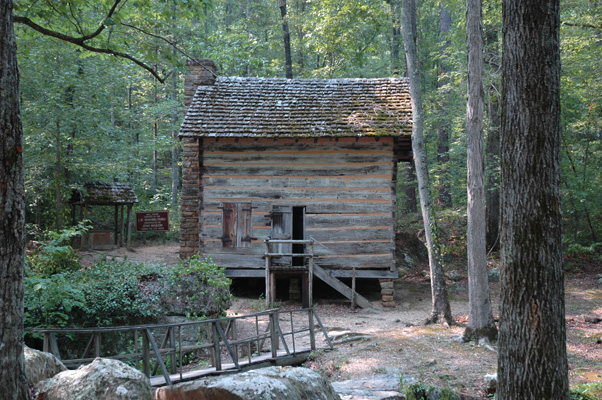
Cool little 1840's restored cabin at Tishomingo State Park
We arrived at the park at near 1:00 P.M. on 18 July 2006 after first having collected at nearby J. P. Coleman State Park. Upon entering the park, we talked with a lady at the gatehouse and let her know that we would be collecting ants. She mentioned that the park manager was on the grounds somewhere and that we should talk to him if we saw him.
We then entered the park and proceeded to the back area to collect along the Outcrop Trail, which loops through a beautiful hardwood forest and follows a line of large rock formations with crevices, small caves, and small waterfalls (which were dry due to lack of rainfall) and then along Bear Creek. To get to the trail, we walked across a large swinging bridge that crosses Bear Creek. As we were getting started from the sandy parking lot, we noticed colonies of Dorymyrmex bureni (Trager) in the soil. These extremely fast moving reddish-yellow ants are commonly seen in sandy areas. Also seen nesting in this area was Pheidole bicarinata Mayr, a small soil nesting species. We took a latitude/longitude reading at the parking site of 34°36'21"N 88°10'45"W, and although this was not entirely indicative of the area we collected in because we walked down the trail for some distance, it gave an idea of where we were.
We were still hot from the morning's collecting and it didn't take long before we were even hotter as temperatures were at or near 100° F. Compounding the heat was the fact that the area was unbelievably dry due to the lack of substantial rainfall in recent months, making ant collecting more challenging than usual. However, we did find ants in the woods. Especially common, and perhaps less affected by the dry soil conditions, were species that were nesting in rotting wood. Both Aphaenogaster fulva Roger and A.lamellidens Mayr were found to be very common in rotting logs, as was A. carolinensis (Wheeler) which was found nesting in the soil and litter. One of the colonies of A. lamellidens was located just underneath some thick humus at the edge of a large boulder. Two species of acrobat ants, Crematogaster ashmeadi Mayr and C. lineolata (Say) were found crawling on the ground and on trees. Colonies of another wood nesting myrmicine species, Pheidole dentata Mayr, were also found nesting in rotting logs and in the soil. A related species, P. dentigula Smith, was collected in leaf litter.
Workers of Formica pallidefulva Latreille were collected as they scurried over rocks in the area. These very fast, reddish colored ants were difficult to apprehend due to their speed and the complex structure of the landscape. The black carpenter ant, Camponotus pennsylvanicus (DeGeer), was abundant throughout the woods and several colonies were seen in soil under leaf litter. Workers of a more rarely collected species of carpenter ant, C. subbarbatus Emery, were collected from a colony in a rotting pine log. Additional workers were seen or collected in other parts of the woods suggesting that this was good habitat for this species. Representatives of the common forest inhabiting Nylanderia faisonensis (Forel) were collected and was quite abundant in the woods here nesting in leaf litter.
Two species of Temnothorax, T. curvispinosus Mayr and T. pergandei Emery, were collected on the ground at various spots. Although these two species are in the same genus, they are very different in appearance with T. curvispinosus being smaller, yellow, and possessing long propodeal spines, whereas T. pergandei are larger, almost black in appearance (some are reddish), and have proportionally smaller spines.
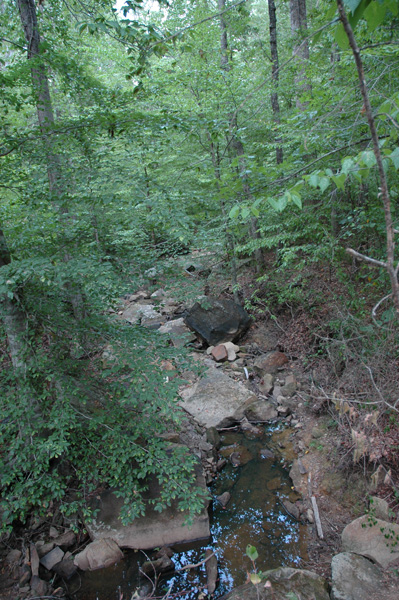
One of the few little creeks that still had water in it
While walking through the woods in the area, we collected six bags of soil and leaf litter, which we carried back to the lab for Berlese funnel extraction. Many of the species we collected by hand were in the samples, but several additional species were also collected including Ponera pennsylvanica Buckley, Stigmatomma pallipes (Haldeman), Proceratium silaceum Roger, Strumigenys laevinasis Smith, S. rostrata Emery, Solenopsis carolinensis, and Myrmecina americana Emery. Of these species P. pennsylvanica, S. carolinensis, and M. americana were the most common in the samples, followed by S. rostrata. Solenopsis carolinensis is a tiny yellowish ant that is common in a variety of habitats and is often confused with the more well-documented thief ant, S. molesta. We have found M. americana to be ubiquitous in wooded areas throughout the southeastern United States. It can usually be found in litter, or soil intermixed with rotting wood material that is beside rotting logs or at the bases of a great variety of trees, both living and dead. It is instantly recognizable by its black color, two pairs of spines on the propodeum, and the sharp carina found on each side of the ventrolateral margin of head. There was only one specimen of S. laevinasis in the litter samples. Members of the genus Strumigenys are tiny, cryptic species that typically live in soil and leaf litter where they are specialized predators of collembolans and other microorganisms. Most people never see these minute ants, which is unfortunate because they are very interesting looking creatures that possess elaborate setation and strange spongy tissue. In Mississippi, this is our largest genus of ants with 29 species reported from the state so far second only in the United States to Florida where 28 species are known to occur. Stigmatomma pallipes, a relatively large, black ant, is another unique ant that has large bidentate mandibles and clypeus, and has the petiole broadly attached to the gaster, giving it a non-ant appearance. The reddish Proceratium species and the dark P. pennsylvanica also have a decidedly non-ant like look and resemble some wingless wasps.
Along part of the trail that bordered Bear Creek, we saw numerous nests of Trachymyrmex septentrionalis (McCook). However, no individuals were collected and we assumed that the workers were deep down in the soil retreating from the intense heat. As we walked back to the truck, we noticed a worker of Temnothorax schaumii Roger resting on the bark of a loblolly pine tree. This small, reddish-brown, cryptic species is often found on oaks, rather than pines. We then loaded up and headed to another site to collect. We first went over to the playground/picnic area to look around, but decided to go elsewhere because there was some sort of church camp going on and we didn't want to disturb anybody. While we were there, we ran into into the park manager, Bill Brekeen, and talked to him a bit about our ant collecting. He was very interested in knowing what we found in the park.
We traveled over to a nice area near a historic cabin hoping to find some soil that was hopefully not as dry along the creek on the lower side of the road. But, the soil here was as dry as the rest of the park and sifting through soil and leaf litter was like sifting dust. Nevertheless, there was ant activity and we collected several species. Both the reddish Formica pallidefulva and the blackish F. subsericea Say were collected crawling on the ground at this spot. As expected, many of the ants we collected on the Outcrop Trail were also found here including Nylanderia faisonensis, P. pennsylvanica, Solenopsis texana, Aphaenogaster carolinensis, A. fulva, A. lamellidens, Crematogaster ashmeadi, C. lineolata, Temnothorax curvispinosus, T. schaumii, and Myrmecina americana.
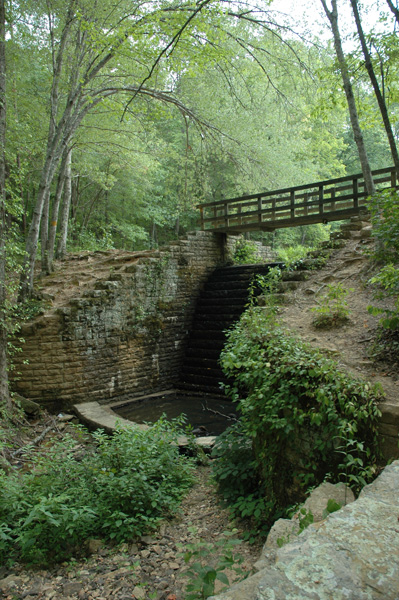
Bridge over waterfall thing, isn't it pretty?
We collected 3 gallons of litter in the woods at the bases of trees, beside rotting logs, and in a depression on a slope. Although the samples were very dry, they yielded several species including many of those collected by hand but also Brachymyrmex depilis Emery, Strumigenys ohioensis Kennedy & Schramm, S. ornata Mayr, and Temnothorax tuscaloosae (Wilson). Brachymyrmex depilis is a tiny, yellowish soil and litter dwelling ant that is common in hilly wooded areas such as is found at the park. Strumigenys ohioensis and S. ornata are also fairly common species found in soil and litter and has been found throughout Mississippi. However, T. tuscaloosae is a rarely collected ant in the United States and is only known from a handful of localities, most of them in Mississippi. It is a dark species with pale yellow appendages. The habitat where it was collected in the park was very similar to other localities in Alabama and Mississippi where this species has been collected.
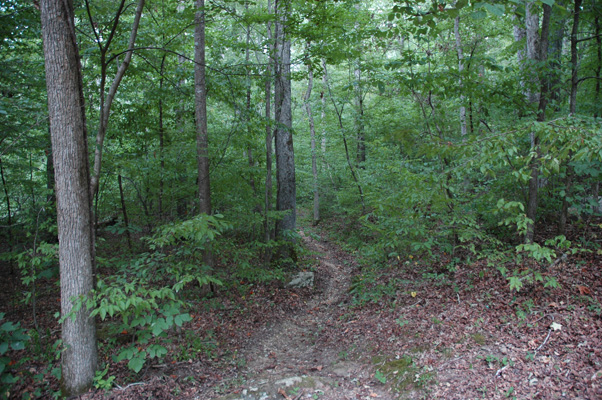
Trail through woods near historic cabin parking area
On a short return to the park on 13 May 2007, MacGown, Hill, and James Lewis again collected ants, but only added two species: Camponotus nearcticus and Proceratium chickasaw. On 26 May 2010, MacGown, Hill, and Lewis returned to the park for further collecting. Ants were collected at the RV campsite at 34°37'00"WN 88°11'43"W and at the primitive campsite area (34°37'00"N 88°11'43"W). We collected 30 species on this trip including 12 that we had not collected previously at the park: Camponotus chromaoides, C. decipiens, C. mississippiensis, Discothryrea testacea, Forelius mccooki, Nylanderia vividula, Prenolepis imparis, Strumigenys angulata, S. louisianae, Solenopsis invicta x richteri (hybrid imported fire ant), and Tapinoma sessile (odorous house ant).
Another collecting trip was made to the park on 15 July 2015 by Joe MacGown and three student workers: Austin Hannah, Claire Caprio, and Kaycee Barnes. Of course, after having already visited the park a few times, it becomes more difficult to add species to the list. However, we did find a few new ones for the park including Camponotus americanus, Nylanderia querna, Ponera exotica, Strumigenys abdita, S. clypeata, and S. reflexa.
A return trip was made to the park by Oliver Yung and Joe MacGown on 8 August 2024 on an extremely hot day. We were happy to add seven new records to the park list! Our first stop was at the historic cabin site. Workers of the black Formica subsericea and the yellowish-orange F. pallidefulva were in abundance as they foraged along the ground and vegetation. Camponotus chromaiodes, C. nearcticus, and C. pennsylvanicus were also found foraging on the ground. The common Aphaenogaster carolinensis was found nesting in rotting wood, Solenopsis carolinensis was nesting under pine bark, and Camponotus snellingi, Crematogaster asheadi, and Temnothorax curvispinosus were all present foraging on trees and other vegetation.
We left the cabin site and headed to the swinging bridge area. As in previous trips, the open sandy parking area near the swinging bridge entrance and just above Bear Creek was a bonaza for nesting ants. Numerous colonies of T. septentrionalis, D. bureni, and of course the hybrid fire ants were noted were all present. Colonies of four Pheidole species not previously found at the park were found nesting in the ground in the open sandy area including P. davisi, which had not been collected in Mississippi since 1930; P. morrisii, a species we typically find in the coastal plain; P. tetra; and P. sp. nr. tetra, probably an undescribed species. A colony of Nylanderia vividula was found along the edge of the open sandy area. Oliver found several species of ants under the bark of a large dead pine tree, which was on the ground, including Hypoponera opacior (a new record for the park), Ponera pennsylvanica, Proceratium silaceum, and Strumigenys dietrichi, a new record for the park.
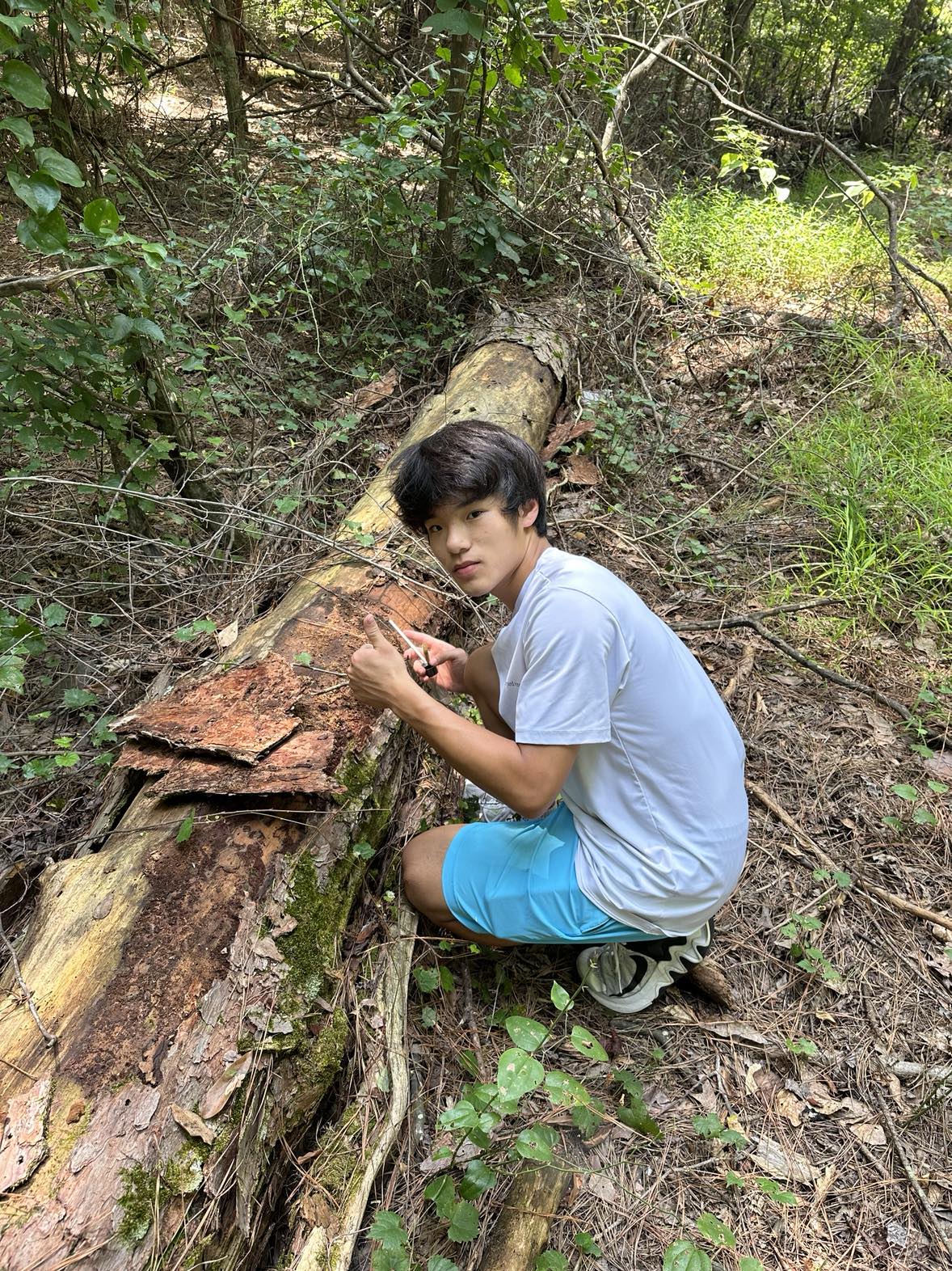
Oliver Yung searching for ants under the bark of a dead tree.
Our next collecting spot was on the lower trail and along the edge of Bear Creek where we found several common species including A. carolinensis, A. fulva, A. lamellidens, Crematogaster ashmeadi, Lasius americanus (a new record for the park), Monomorium minimum (the little black ant), N. faisonensis, and Prenolepis imparis. We then head uphill to the rocky outcrops where we found A. carolinensis, Camponotus americanus, C. chromaiodes, C. pennsylvanicus, N. faisonensis, and Strumigenys louisianae.
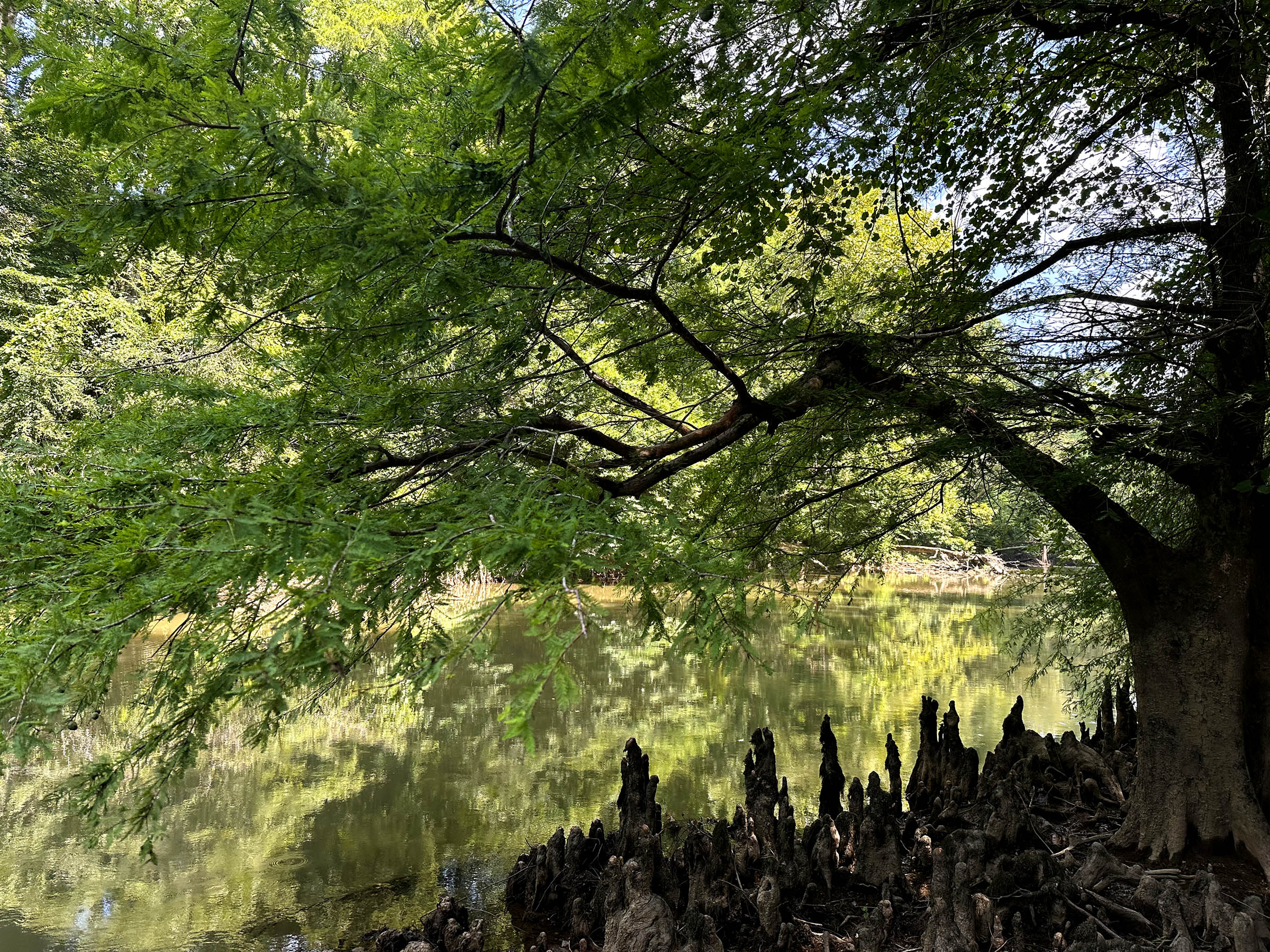
Cyress tree at the edge of Bear Creek.
Thus far, 58 species have been collected at the park. Most of the species collected are relatively common throughout our state and would be typical residents of forested habitats. However, a few rarely collected species were found including Discothryea testacea, Pheidole davisi, Proceratium chickasaw, P. silaceum, Strumigenys laevinasis, and Temnothorax tuscaloosae. Of these, T. tuscaloosae is considered to be the most rare and was only recently reported from Mississippi (MacGown and Brown, 2006). The majority of the known specimens in the world are from Mississippi and are housed in the Mississippi Entomological Museum. Strumigenys laevinasis is only known from six counties in the state and when we have found it, it has always been in small numbers. Likewise, Proceratium silaceum has been found in scattered localities in the state, but always in low numbers. Two other species, Camponotus subbarbatus and Strumigenys ohioensis were also only recently reported to occur in the state (MacGown and Brown, 2006, MacGown et al., 2005), but we now know that these species are relatively common in the region.
List of ant species collected at Tishomingo State Park (arranged alphabetically)
Aphaenogaster carolinensis (Wheeler)
Aphaenogaster fulva Roger
Aphaenogaster lamellidens Mayr
Aphaenogaster treatae Forel
Brachymyrmex depilis Emery
Camponotus americanus Mayr
Camponotus chromaiodes Bolton
Camponotus decipiens Emery
Camponotus nearcticus Emery
Camponotus pennsylvanicus (DeGeer)
Camponotus snellingi Bolton
Camponotus subbarbatus Emery
Colobopsis mississippiensis (Smith)
Crematogaster ashmeadi Mayr
Crematogaster lineolata (Say)
Discothyrea testacea Roger
Dorymyrmex bureni (Trager)
Forelius mccooki (McCook)
Formica pallidefulva Latreille
Formica subsericea Say
Hypoponera opacior (Forel)
Lasius americanus Emery
Monomorium minimum (Buckley)
Myrmecina americana Emery
Nylanderia faisonensis (Forel)
Nylanderia querna Kallal and LaPolla
Nylanderia vividula (Nylander)
Pheidole bicarinata Mayr
Pheidole davisi Wheeler
Pheidole dentata Mayr
Pheidole morrisi Forel
Pheidole dentigula Smith
Pheidole tetra Creighton
Pheidole sp.-01
Ponera exotica Smith
Ponera pennsylvanica Buckley
Prenolepis imparis (Say)
Proceratium chickasaw de Andrade
Proceratium silaceum Roger
Solenopsis carolinensis Forel
Solenopsis invicta x richteri
Solenopsis richteri Forel
Stigmatomma pallipes (Haldeman)
Strumigenys abdita Wesson & Wesson
Strumigenys angulata Smith
Strumigenys clypeata Roger
Strumigenys dietrichi Smith
Strumigenys laevinasis Smith
Strumigenys louisianae Roger
Strumigenys ohioensis Kennedy & Schramm
Strumigenys ornata Mayr
Strumigenys reflexa Wesson & Wesson
Strumigenys rostrata Emery
Tapinoma sessile (Say)
Temnothorax curvispinosus Mayr
Temnothorax pergandei Emery
Temnothorax schaumii Roger
Temnothorax tuscaloosae (Wilson)
Trachymyrmex septentrionalis
MacGown, J. A., R. L. Brown, and J. G. Hill. 2005. An annotated list of the Pyramica (Hymenoptera: Formicidae: Dacetini) of Mississippi. Journal of the Kansas Entomological Society 78: 285–289. [pdf]
MacGown, J. A. and R. L. Brown. 2006. Survey of Ants (Hymenoptera: Formicidae) of the Tombigbee National Forest in Mississippi. Kansas Entomological Society 79: 325-340. [pdf]


